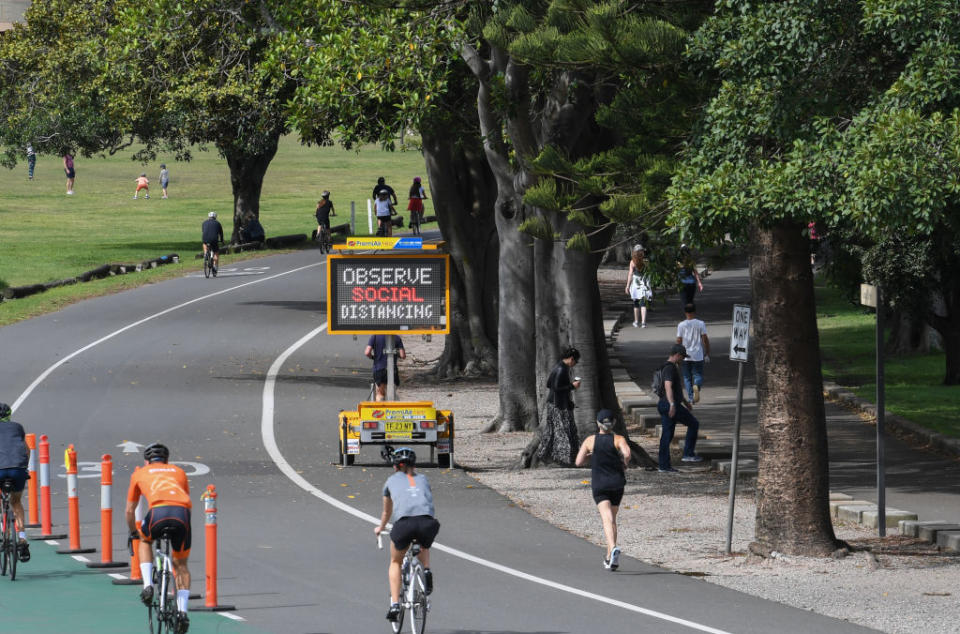Why Australia 'will achieve' coronavirus eradication despite rejecting elusive strategy
While appearing to be tantalisingly close, Scott Morrison confirmed on Thursday Australia wasn’t pursuing a strategy to eliminate the novel coronavirus from the country.
The prime minister stressed it wasn’t a move he was willing to take in order to protect the nation’s already badly-damaged economy.
“The eradication pathway involves an approach which would see even more economic restrictions than are currently in place and that is not seen to be, a wise, in our view, trade-off in how we are managing the two crises that we are facing, the economic one and of course the health one,” he told reporters.
Yet for Professor Archie Clements, an epidemiologist at Curtin University, he believes there’s no need for a so-called eradication strategy as Australia’s current measures will achieve the same results anyway.

“I think [eradication] is something Australia will achieve whether the prime minister says it or otherwise,” he told Yahoo News Australia.
The federal government is instead pursuing a suppression strategy, which Mr Morrison insisted is “the right plan for Australia”.
Prof Clements agrees, saying it is the correct route in tackling the outbreak in a proportionate way.
“Epidemic 101 says any response to the epidemic has to be proportionate to the health consequences of the epidemic and the risks associated with any decisions so I’m comfortable Australia has taken a proportionate approach,” he said.
Prof Clements said Australia may even look back once the pandemic is over and thinks there were elements of the restrictions that didn’t need to be as stringent as they have been.
“I think in the aftermath when we do the post-mortem on the epidemic we may ask ourselves ‘did we go too far? Did we go too hard?’ Were the social measures warranted given the scale of the problem?’”
Chief Medical Officer Brendan Murphy said a major part of the current suppression strategy was to ensure each state’s reproductive rate – the number of infected people who pass the virus on – was kept below one per cent.
With the exception of Tasmania following its recent hospital cluster, all states and territories are currently succeeding in keeping that figure “well under” one per cent, Prof Clements said.

Australia is currently averaging about 40 new cases daily and that figure appears to be lowering even further.
This current rate is being achieved by what is effectively a lockdown, where public gatherings are limited to two, restaurants, cafes and bars are limited to takeaway only and people can only leave their homes for limited reasons or face the prospect of hefty on-the-spot fines.
New Zealand’s strategy similar to Australia’s, expert says
New Zealand is a country which has been pursuing eradication, and while managing to keep numbers extremely low, it has so far failed to eradicate the virus with a more stringent lockdown than Australia implemented in late March.
Mr Morrison said Australia’s current, less stringent strategy has so far managed to “get as good if not a better outcome” than New Zealand.
Prof Clements believes while New Zealand is implementing stricter social distancing rules, Australia and New Zealand’s responses aren’t too dissimilar “on face value” and some variances are down to “semantic differences”.
The prime minister told ABC’s 7.30 on Thursday night that chasing eradication was a dangerous game as “it’s very elusive”.
“The costs to those livelihoods are very significant, with no real clear additional benefit, at least from the evidence we’re getting at the moment.
“You can win the health war and lose the economic war, but you’ve got to deal with both of them at the same time.”
Mr Morrison echoed the sentiments of Professor Tony Blakely, an epidemiologist from the University of Melbourne, who earlier this month stressed there was a “low chance of success” if the government pursued elimination.
Yet with the results currently being produced, rates of infection could ultimately lead to something close to eradication from the current suppression strategy.
Australia’s success even prompted Federal Health Minister Greg Hunt to boast earlier this week any country in the world would willingly swap places with Australia at this stage.
'Certainly not the peak yet': WHO's coronavirus warning as countries ease restrictions
The six WHO requirements Australia must meet before lifting coronavirus restrictions
“It's quite possible we could eradicate the virus in some parts of the country,” Prof Murphy said on Thursday.
Prof Clements said the current testing, tracing and isolation measures alongside social distancing, which according to Mr Morrison will be ramped up in the coming weeks, will allow Australia to eradicate the virus.
“What we’re heading for is extinction of the epidemic through suppression rather than aggressively finding every last case,” he told Yahoo News Australia
But Prof Murphy said if that was achieved, the country could not rest on its laurels as there would still be the potential for asymptomatic cases to be spreading the virus.
He did admit, however, that achieving eradication would be “fantastic” for Australia.
Do you have a story tip? Email: newsroomau@yahoonews.com.
You can also follow us on Facebook, Instagram and Twitter and download the Yahoo News app from the App Store or Google Play.





